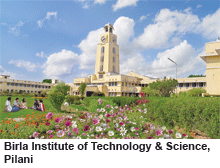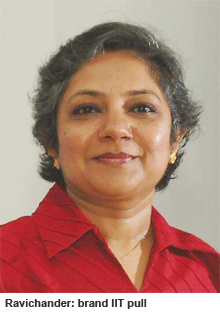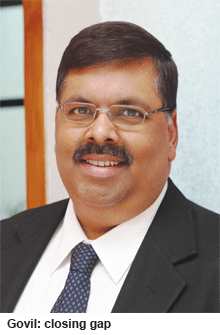Given the extraordinary exclusivity of IITs which admit a mere 2 percent of aspiring engineering students annually, your editors decided to eliminate them from EducationWorld-C fore’s inaugural rankings of India’s most admired engineering colleges. Dilip Thakore reports
 It’s well-known the prosperity of the developed oecd nations of the first world — and latterly of China — has been built upon the foundation of an industrial base or manufacturing capability. Yet despite the early start in industrial manufacturing given to the nation by pre-independence era entrepreneurs such as J.N.Tata, G.D. Birla, Walchand Hirachand and Lala Shri Ram among others, aspirational post-independence India has not been able to develop sufficient industrial and manufacturing capability, the precondition of attaining developed nation status. According to an Assocham (Associated Chambers of Commerce) press release (May 12), the contribution of the manufacturing sector to India’s GDP is a mere 15.2 percent. Against this the contribution of manufacturing to GDP in developed OECD countries and China averages 20-25 percent and 30 percent respectively.
It’s well-known the prosperity of the developed oecd nations of the first world — and latterly of China — has been built upon the foundation of an industrial base or manufacturing capability. Yet despite the early start in industrial manufacturing given to the nation by pre-independence era entrepreneurs such as J.N.Tata, G.D. Birla, Walchand Hirachand and Lala Shri Ram among others, aspirational post-independence India has not been able to develop sufficient industrial and manufacturing capability, the precondition of attaining developed nation status. According to an Assocham (Associated Chambers of Commerce) press release (May 12), the contribution of the manufacturing sector to India’s GDP is a mere 15.2 percent. Against this the contribution of manufacturing to GDP in developed OECD countries and China averages 20-25 percent and 30 percent respectively.
The fault that contemporary India is an industrial also-ran in the rapidly emerging global marketplace is not only of the Nehru-Indira dynasty which jettisoned India’s ancient, tried and tested private enterprise-driven economic development culture and imposed state-driven capitalism, aka public sector enterprises (PSEs) to dominate “the commanding heights of the economy”, but also of the said pre-independence India’s industry pioneers who ill-advisedly endorsed this development model (Bombay Plan, 1944). Lumbered with a cumbersome, high-cost public sector continuously mismanaged by inept, risks-averse bureaucrats, PSE monopolies entrusted with the task of building the nation’s infrastructure and capital goods industries have been a massive failure.
However, historic ideology and policy wrong choices apart, it’s also true that a contributory cause of post-independence India’s failure to establish a globally competitive manufacturing base is inferior engineering education. Although it is commonly (and globally) accepted that the country’s seven vintage Indian Institutes of Technology (IITs) — a precious Nehruvian legacy — graduate world-class engineers valued by industrial corporations around the world, and especially in the US where many of them have emerged pioneer entrepr-eneurs in their own right, it’s a sobering thought that IIT-Delhi is ranked 212 in the QS World University Rankings 2013. Though several IITs are ranked higher in the authoritative QS and Times Higher Education sectoral league tables of the world’s most respected universities and among Asian universities, even so they have been overtaken by newly-established varsities in China, South Korea, Japan and Singapore (see table).
Nevertheless it is well accepted domestically that the seven vintage IITs sited in Mumbai, Delhi, Kanpur, Kharagpur, Madras (Chennai), Roorkee and Guwahati are the crown jewels of Indian technology education. As such they routinely dominate the ranking league tables compiled by a host of indigenous news and media publications including India Today, Outlook, Businessworld, Business India, Economic Times and Business Today among others. The huge reputation which the IITs enjoy for delivering world-class engineering sciences educa-tion, is also testified by the massive annual stampede of hopeful higher secondary school-leavers who prepare intensively in coaching schools to top the joint entrance exam of the IITs (IIT-JEE), held nationwide in April every year. Last year 500,000 PCM (physics, chemistry and maths) school-leavers wrote IIT-JEE, of whom a mere 10,000 (2 percent) were admitted into the seven premier IITs and nine fledgling IITs which are yet to get off the ground.
Given the extraordinary exclusivity of IITs and bearing in mind that the fledgling new institutes don’t even have proper campuses, your editors decided to eliminate the IITs from Education-World’s first ever perceptual survey of India’s most admired engineering colleges. We agreed that since the IITs are beyond the reach of all except a tiny sliver of 98 percentile school-leavers, it makes better sense to rate and rank the Top 100 of the 3,400 engineering and technology undergrad institutions countrywide to enable parents/students to choose the most suitable institute from next-best colleges.
 As usual, to gauge informed public opinion and compile league tables to rate and rank India’s other most admired engineering/technology undergrad education institutions, we turned to the Delhi-based Centre for Forecasting and Research Pvt. Ltd (C fore, estb. 2000), one of the country’s premier market research and public opinion polling companies. Over the past seven years, C fore has conducted expert field research for the EducationWorld India School Rankings and the EW India Preschool Rankings which are eagerly awaited big ticket annual events for preschool-class XII education establishments across the country.
As usual, to gauge informed public opinion and compile league tables to rate and rank India’s other most admired engineering/technology undergrad education institutions, we turned to the Delhi-based Centre for Forecasting and Research Pvt. Ltd (C fore, estb. 2000), one of the country’s premier market research and public opinion polling companies. Over the past seven years, C fore has conducted expert field research for the EducationWorld India School Rankings and the EW India Preschool Rankings which are eagerly awaited big ticket annual events for preschool-class XII education establishments across the country.
“We felt the best methodology to gauge the public reputation of other engineering colleges and to rank them accordingly, would be by way of an objective perceptual survey of an informed public. Therefore perceptual data was collected using a structured questionnaire which was administered to faculty members and final year students of 511 engineering colleges across the country. Respondents were asked to rate institutes they were familiar with on a ten point scale on seven parameters of academic excellence, and were also asked to assign weightage to each parameter which was subsequently averaged. In all, 1,126 faculty members and 1,211 final year students of a mix of engineering/technology institutes countrywide were interviewed, care being taken that not more than one member of each faculty was polled and ratings which faculty members gave to their own institutes not considered. Low-profile institutions unknown to at least 25 faculty and 25 students were eliminated from the rankings,” says Premchand Palety, the promoter chief executive of C fore, fresh from his triumph of having predicted the outcome of the Karnataka state legis-lative assembly election of May 5 with pinpoint accuracy.
The EW-C fore non-IITs ranking of India’s Top 100 engineering colleges serve a useful purpose inasmuch as in recent years the quality of output of the country’s non-IIT institutions has taken a shellacking. In 2005, a Nasscom-McKinsey World Institute study which came to the devastating conclusion that 75 percent of graduates certified by the country’s 3,400 engineering colleges were unqualified for employment in multinational companies, severely dented the reputation of Indian engin-eering professionals and created waves worldwide.
The fallout of this report has been elaborate testing of certified graduates as also establishment of massive training and induction facilities within corporate India and the country’s services exporting information technology (IT) companies in particular. Indeed the in-house training establishments set up by IT majors such as TCS, Infosys, Wipro and Cognizant are almost of university scale and administer intensive ten-hours daily induction training for as long as six months to get certified engineering graduates job-ready.
Almost a decade after the Nasscom-McKinsey study was made public and imposed a low-end ‘techno-coolie’ image upon India’s IT companies and engineers, there are signs of remorse within the Delhi-based Nasscom (National Association of Software and Services Companies). “The alleged observation of the Nasscom-Mckinsey report that 75 percent of India’s engineering grad-uates are unemployable in multi-nationals has been misinterpreted and misreported. Actually it said that 75 percent were willing to work in the IT industry — with the rest going to other industries — of whom 25 percent were employable by IT multinationals. Since then the quality of engineering graduates has improved and of the 360,000 technology graduates willing to work in the IT industry, over one-third are employment ready,” says Dr. Sandhya Chintal, who heads the education vertical of Nasscom.
 According to Chintala, since publication of the Nasscom-McKinsey report, the association has launched several initiatives to “build bridges” connecting engineering/technology institutes with the IT and ITES industries. Under its Foundational Skills in Education programme the association supplies industry-specified courseware and curriculums to academia to improve the employability of students. “Our course-ware available to engineering and technology institutes includes 67 industry-approved entry-level job specifications,” she adds.
According to Chintala, since publication of the Nasscom-McKinsey report, the association has launched several initiatives to “build bridges” connecting engineering/technology institutes with the IT and ITES industries. Under its Foundational Skills in Education programme the association supplies industry-specified courseware and curriculums to academia to improve the employability of students. “Our course-ware available to engineering and technology institutes includes 67 industry-approved entry-level job specifications,” she adds.
While informed opinion is unanimous that the IITs are way ahead of the pack in terms of the quality and industry-readiness of the 9,000 plus graduates they produce annually, the general consensus is that the gap between them and the 30 Central government-sponsored NITs (National Institutes of Technology) and the best private sector engineering colleges is closing. “The IITs graduate the brightest and best students because Brand IIT attracts the country’s best science and math school-leavers rather than because of superior faculty and infrastructure. On the contrary, there are several tier-II engineering colleges which offer better faculty and/or infrastructure. While it’s true that about 70 percent of the best engineering graduates are produced by the IITs, the other 30 percent of equally competent and industry-ready young engineers from tier-II institutes are readily recruited by Indian IT majors and even multinationals,” says Hema Ravichander, former global head of human resources at Infosys Technologies and currently a Bangalore-based pan-India HR strategic advisor.
 The on-the-ground reality that committed and purpose-driven prom-oters, administrators and faculty of India’s next best engineering colleges have made serious and successful efforts to raise teaching-learning and research standards to IIT levels, is confirmed by Saurabh Govil, senior vice president of Wipro Ltd, the globe-girdling IT software and services major (revenue: Rs.37,704 crore in fiscal 2012-13) which campus-recruited several thousand (national secret) trainee engi-neers last year. “The quality of output gap between the IITs and top 20 engineering colleges in your survey has closed considerably within the past few years. As a result the best students of top-ranked tier-II engineering institutes are as knowledgeable and industry-ready as the average IIT graduate and sometimes even more so. This is a very promising and welcome development of the past few years,” says Govil, an alum of XLRI, Jamshedpur who worked with GE and ITC prior to signing up with Wipro in 2009.
The on-the-ground reality that committed and purpose-driven prom-oters, administrators and faculty of India’s next best engineering colleges have made serious and successful efforts to raise teaching-learning and research standards to IIT levels, is confirmed by Saurabh Govil, senior vice president of Wipro Ltd, the globe-girdling IT software and services major (revenue: Rs.37,704 crore in fiscal 2012-13) which campus-recruited several thousand (national secret) trainee engi-neers last year. “The quality of output gap between the IITs and top 20 engineering colleges in your survey has closed considerably within the past few years. As a result the best students of top-ranked tier-II engineering institutes are as knowledgeable and industry-ready as the average IIT graduate and sometimes even more so. This is a very promising and welcome development of the past few years,” says Govil, an alum of XLRI, Jamshedpur who worked with GE and ITC prior to signing up with Wipro in 2009.
Against this backdrop of government (via the NITs), committed private educationists and heads of the country’s other engineering colleges and techn-ology institutes making a determined effort to raise teaching-learning, rese-arch and innovation standards to catch up with Brand IIT, the survey commissioned by EducationWorld to evaluate and rank India’s next-best Top 100 engineering colleges will serve the useful purpose of aiding and abetting higher secondary school-leavers who don’t make it into IITs to choose institutes most suitable to their aptitudes and preferences.
To read the all-India, state and parameters league tables visit http://www.educationworld.in/rank-engineering/2013.html